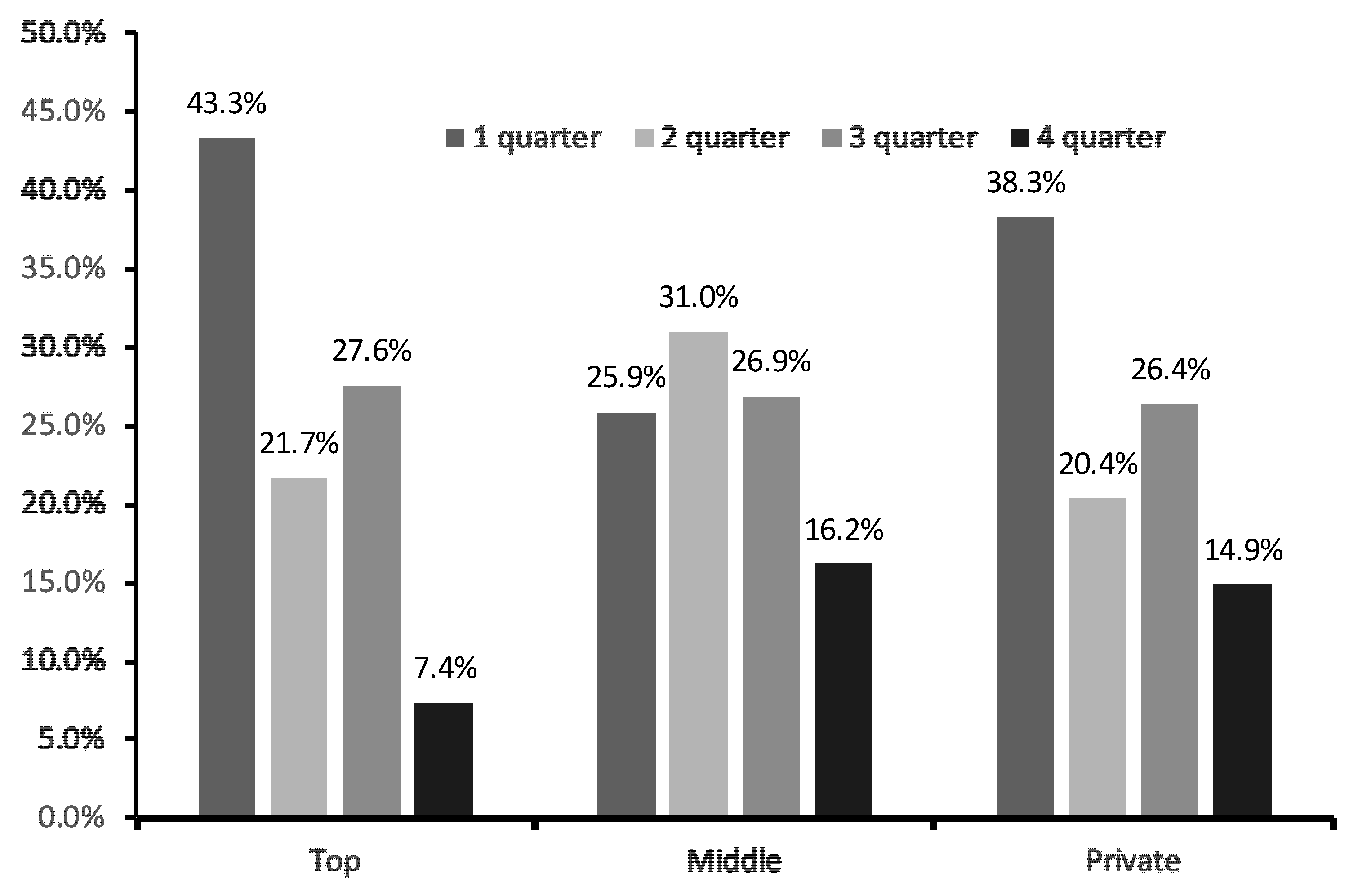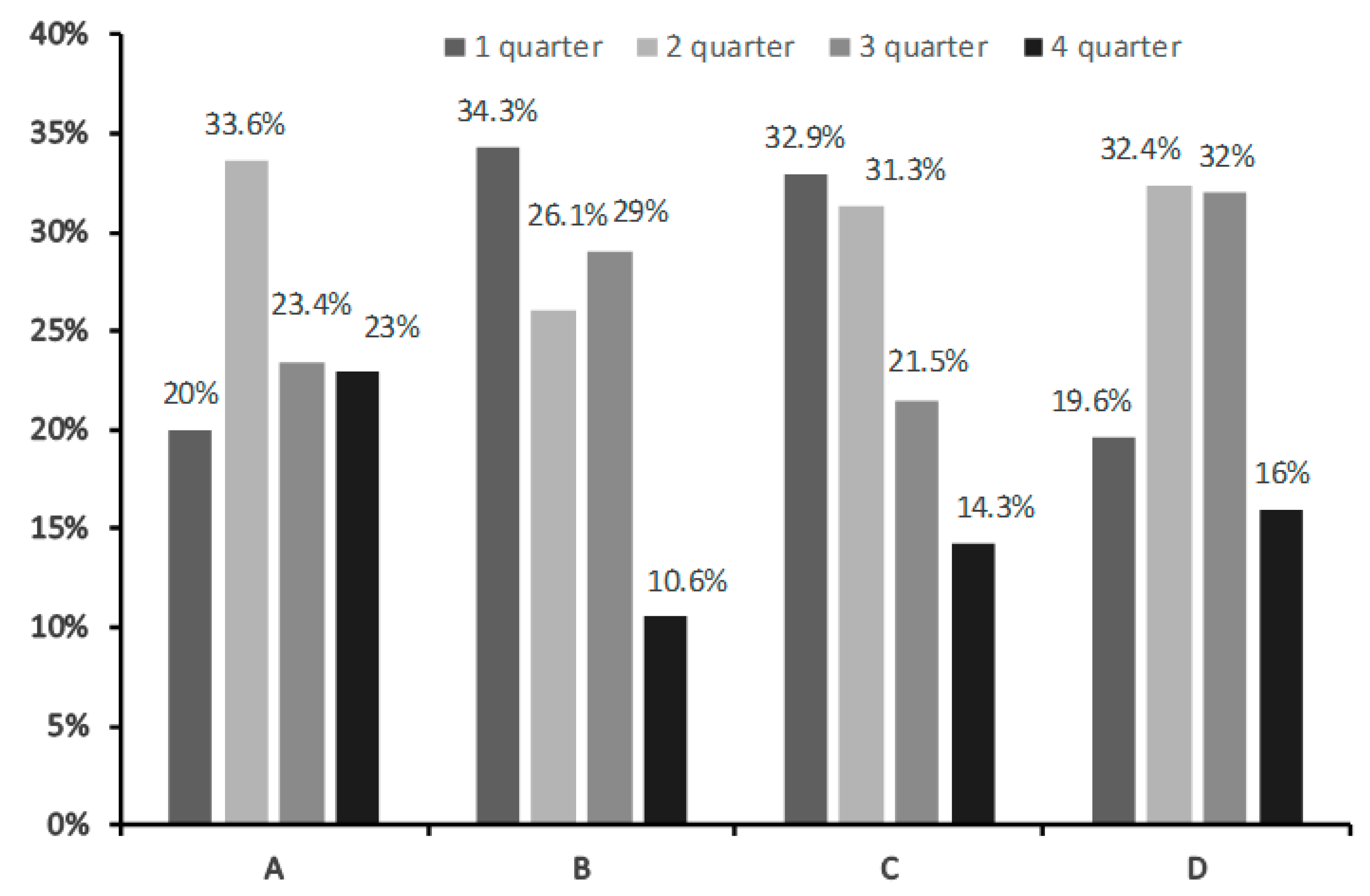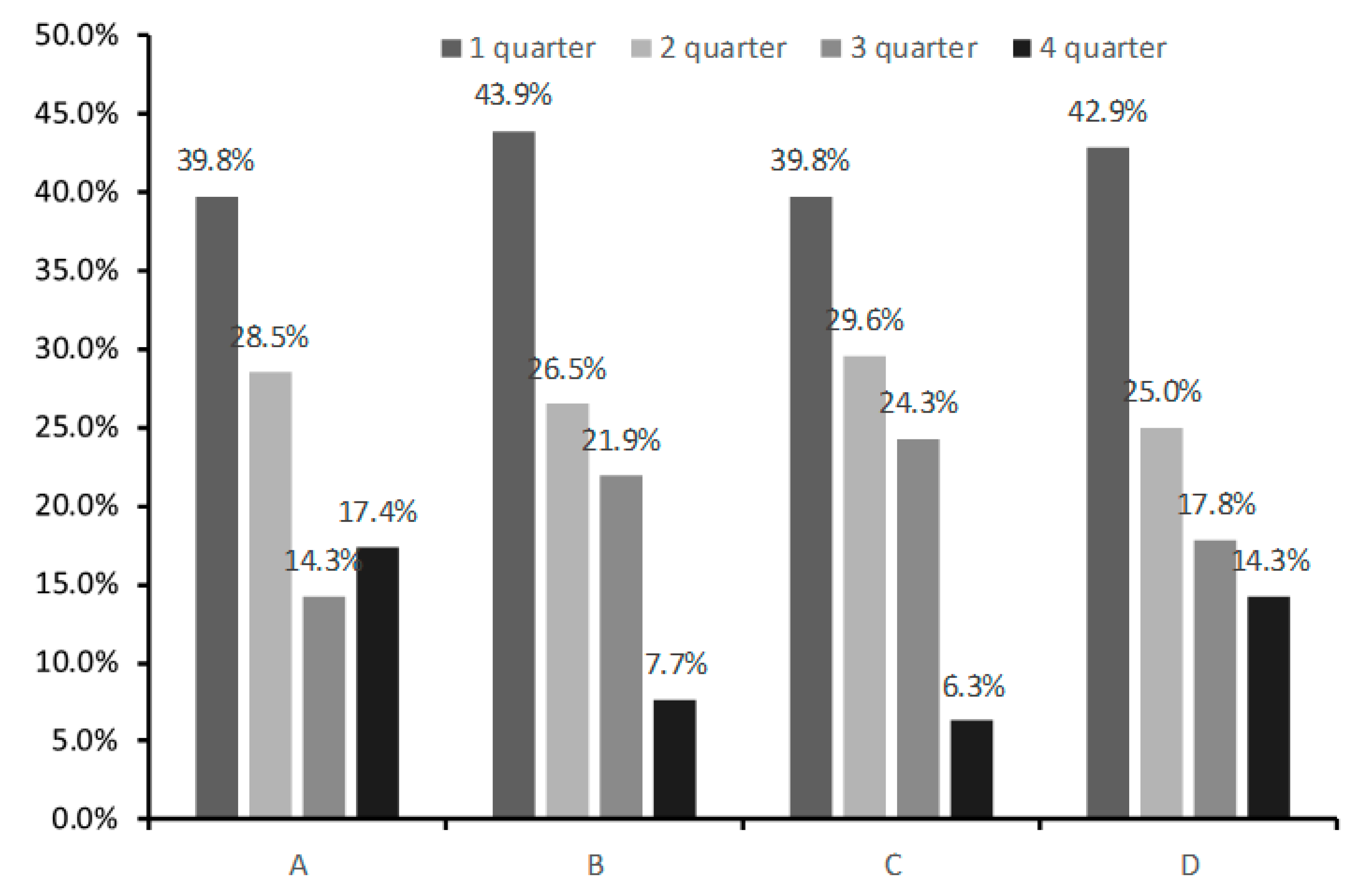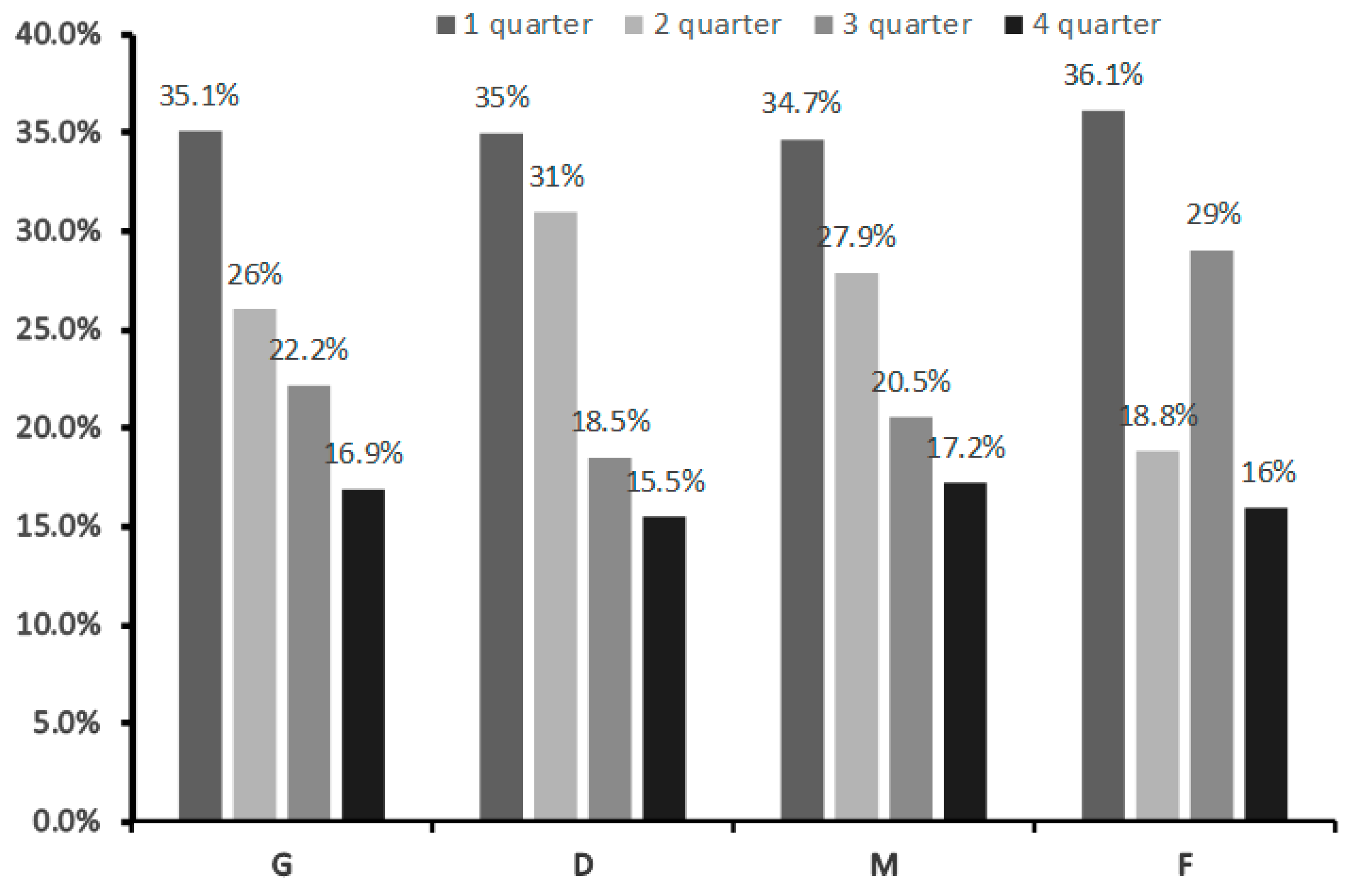Prevalence of Relative Age Effect in Russian Soccer: The Role of Chronological Age and Performance
Abstract
:1. Introduction
2. Materials and Methods
2.1. Study Design and Participants
2.2. Data and Statistical Analyses
3. Results
3.1. Performance Level of Soccer Levels
3.2. Age and Performance Level of Soccer Academies
3.3. Playing Position
4. Discussion
5. Conclusions
Author Contributions
Funding
Acknowledgments
Conflicts of Interest
References
- Bell, J.F.; Massey, A.; Dexter, T. Birthdate and ratings of sporting achievement: Analysis of physical education gcse results. Eur. J. Phys. Educ. 1997, 2, 160–166. [Google Scholar] [CrossRef]
- Armstrong, H.G. A comparison of the performance of summer and automn-born children at eleven and sixteen. Br. J. Educ. Psychol. 1966, 36, 72–76. [Google Scholar] [CrossRef] [PubMed]
- Freyman, R. Further evidence on the effect of date of birth on subsequent school performance. Educ. Res. 1965, 8, 58–64. [Google Scholar] [CrossRef]
- Heneghan, J.F.; Herron, M.C. Relative age effects in American professional football. J. Quant. Anal. Sports 2019, 15, 185–202. [Google Scholar] [CrossRef]
- Sprietsma, M. Effect of relative age in the first grade of primary school on long-term scholastic results: International comparative evidence using pisa 2003. Educ. Econ. 2010, 18, 1–32. [Google Scholar]
- Barnsley, R.H.; Thompson, A.H.; Barnsley, P.E. Hockey success and birthdate: The rae. Can. Assoc. Health Phys. Educ. Recreat. J. 1985, 51, 23–28. [Google Scholar]
- Luca, F.; Gibbs, B.G.; Jarvis, J.A.; Rossi, G. The relative age effect reversal among the National Hockey League elite. PLoS ONE 2017, 12, e0182827. [Google Scholar] [CrossRef]
- Malina, R.M.; Cumming, S.P.; Morano, P.J.; Barron, M.; Miller, S.J. Maturity status of youth football players: A noninvasive estimate. Med. Sci. Sports Exerc. 2005, 37, 1044–1052. [Google Scholar]
- Cobley, S.P.; Schorer, J.; Baker, J. Relative age effects in professional german soccer: A historical analysis. J. Sports Sci. 2008, 26, 1531–1538. [Google Scholar] [CrossRef]
- Malina, R.M.; Bouchard, C.; Bar-Or, O. Growth, Maturation and Physical Activity; Human Kinetics: Champaign, IL, USA, 2004. [Google Scholar]
- Cumming, S.P.; Standage, M.; Malina, R.M. Youth soccer: A biocultural perspective. In Children and Youth in Organized Sports; Silva, C., Malina, R.M., Eds.; Coimbra University Press: Coimbra, Portugal, 2004; pp. 209–221. [Google Scholar]
- Malina, R.M.; Figueiredo, A.J.; Coelho-e-Silva, M.J. Body size of male youth soccer players: 1978–2015. Sports Med. 2017, 47, 1983–1992. [Google Scholar] [CrossRef]
- Unnithan, V.; White, J.; Georgiou, A.; Iga, J.; Drust, B. Talent identification in youth soccer. J. Sports Sci. 2012, 30, 1719–1726. [Google Scholar] [CrossRef] [PubMed]
- Augste, C.; Lames, M. The relative age effect and success in german elite u-17 soccer teams. J. Sports Sci. 2011, 29, 983–987. [Google Scholar] [CrossRef] [PubMed]
- Skorski, S.; Skorski, S.; Faude, O.; Hammes, D.; Meyer, T. The relative age effect in german elite youth soccer: Implications for a successful career. Int. J. Sports Physiol. Perform. 2016, 11, 370–376. [Google Scholar] [CrossRef] [PubMed]
- del Campo, D.G.D.; Vicedo, J.C.P.; Villora, S.G.; Jordan, O.R.C. The relative age effect in youth soccer players from spain. J. Sports Sci. Med. 2010, 9, 190–198. [Google Scholar]
- Lovell, R.; Towlson, C.; Parkin, G.; Portas, M.; Vaeyens, R.; Cobley, S. Soccer player characteristics in english lower-league development programmes: The relationships between relative age, maturation, anthropometry and physical fitness. PLoS ONE 2015, 10, e0137238. [Google Scholar] [CrossRef] [PubMed]
- Gil, S.M.; Badiola, A.; Bidaurrazaga-Letona, I.; Zabala-Lili, J.; Gravina, L.; Santos-Concejero, J.; Lekue, J.A.; Granados, C. Relationship between the relative age effect and anthropometry, maturity and performance in young soccer players. J. Sports Sci. 2014, 32, 479–486. [Google Scholar] [CrossRef]
- Deprez, D.; Vaeyens, R.; Coutts, A.J.; Lenoir, M.; Philippaerts, R. Relative age effect and yo-yo ir1 in youth soccer. Int. J. Sports Med. 2012, 33, 987–993. [Google Scholar] [CrossRef]
- Deprez, D.; Coutts, A.J.; Fransen, J.; Deconinck, F.; Lenoir, M.; Vaeyens, R.; Philippaerts, R. Relative age, biological maturation and anaerobic characteristics in elite youth soccer players. Int. J. Sports Med. 2013, 34, 897–903. [Google Scholar] [CrossRef]
- Malina, R.M. Maturity status and injury risk in youth soccer players. Clin. J. Sport Med. 2010, 20, 132–133. [Google Scholar] [CrossRef]
- Helsen, W.F.; Baker, J.; Michiels, S.; Schorer, J.; van Winckel, J.; Williams, A.M. The relative age effect in european professional soccer: Did ten years of research make any difference? J. Sports Sci. 2012, 30, 1665–1671. [Google Scholar] [CrossRef]
- Helsen, W.F.; Van Winckel, J.; Williams, A.M. The relative age effect in youth soccer across europe. J. Sports Sci. 2005, 23, 629–636. [Google Scholar] [CrossRef] [PubMed]
- Sæther, S.A. Presence of the relative age effect and its effect on playing time among under-20 players in the norwegian premier league tippeligaen—A four-year follow up. Monten. J. Sports Sci. Med. 2016, 5, 11–15. [Google Scholar]
- Mujika, I.; Vaeyens, R.; Matthys, S.P.J.; Santisteban, J.; Goiriena, J.; Philippaerts, R. The relative age effect in a professional football club setting. J. Sports Sci. 2009, 27, 1153–1158. [Google Scholar] [CrossRef] [PubMed]
- Lidor, R.; Côté, J.; Arnon, M.; Zeev, A.; Cohen-Maoz, S. Relative age and birthplace effects in division 1 players—Do they exist in a small country? Talent Dev. Excell. 2010, 2, 181–192. [Google Scholar]
- Andrade-Souza, V.A.; Moniz, F.; Teoldo, I. Relative age effect in fifa u17 emirates 2013 world cup: Analysis of players who effectively participated in the matches. Mot. Rev. De Educ. Fis. 2015, 21, 403–406. [Google Scholar] [CrossRef]
- Helsen, W.F.; Starkes, J.L.; Van Winckel, J. The influence of relative age on success and dropout in male soccer players. Am. J. Hum. Biol. 1998, 10, 791–798. [Google Scholar] [CrossRef]
- Musch, J.; Grondin, S. Unequal competition as an impediment to personal development: A review of the relative age effect in sport. Dev. Rev. 2001, 21, 147–167. [Google Scholar] [CrossRef]
- Reilly, T.; Bangsbo, J.; Franks, A. Anthropometric and physiological predispositions for elite soccer. J. Sports Sci. 2000, 18, 669–683. [Google Scholar] [CrossRef]
- Williams, A.M.; Reilly, T. Talent identification and development in soccer. J. Sports Sci. 2000, 18, 657–667. [Google Scholar] [CrossRef]






© 2019 by the authors. Licensee MDPI, Basel, Switzerland. This article is an open access article distributed under the terms and conditions of the Creative Commons Attribution (CC BY) license (http://creativecommons.org/licenses/by/4.0/).
Share and Cite
Bezuglov, E.N.; Nikolaidis, P.T.; Khaitin, V.; Usmanova, E.; Luibushkina, A.; Repetiuk, A.; Waśkiewicz, Z.; Gerasimuk, D.; Rosemann, T.; Knechtle, B. Prevalence of Relative Age Effect in Russian Soccer: The Role of Chronological Age and Performance. Int. J. Environ. Res. Public Health 2019, 16, 4055. https://doi.org/10.3390/ijerph16214055
Bezuglov EN, Nikolaidis PT, Khaitin V, Usmanova E, Luibushkina A, Repetiuk A, Waśkiewicz Z, Gerasimuk D, Rosemann T, Knechtle B. Prevalence of Relative Age Effect in Russian Soccer: The Role of Chronological Age and Performance. International Journal of Environmental Research and Public Health. 2019; 16(21):4055. https://doi.org/10.3390/ijerph16214055
Chicago/Turabian StyleBezuglov, Eduard Nikolayevich, Pantelis Theodoros Nikolaidis, Vladimir Khaitin, Elvira Usmanova, Anastasiya Luibushkina, Alexey Repetiuk, Zbigniew Waśkiewicz, Dagmara Gerasimuk, Thomas Rosemann, and Beat Knechtle. 2019. "Prevalence of Relative Age Effect in Russian Soccer: The Role of Chronological Age and Performance" International Journal of Environmental Research and Public Health 16, no. 21: 4055. https://doi.org/10.3390/ijerph16214055
APA StyleBezuglov, E. N., Nikolaidis, P. T., Khaitin, V., Usmanova, E., Luibushkina, A., Repetiuk, A., Waśkiewicz, Z., Gerasimuk, D., Rosemann, T., & Knechtle, B. (2019). Prevalence of Relative Age Effect in Russian Soccer: The Role of Chronological Age and Performance. International Journal of Environmental Research and Public Health, 16(21), 4055. https://doi.org/10.3390/ijerph16214055









